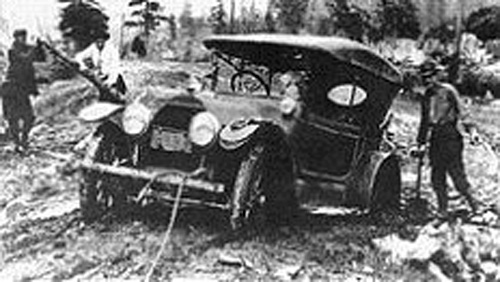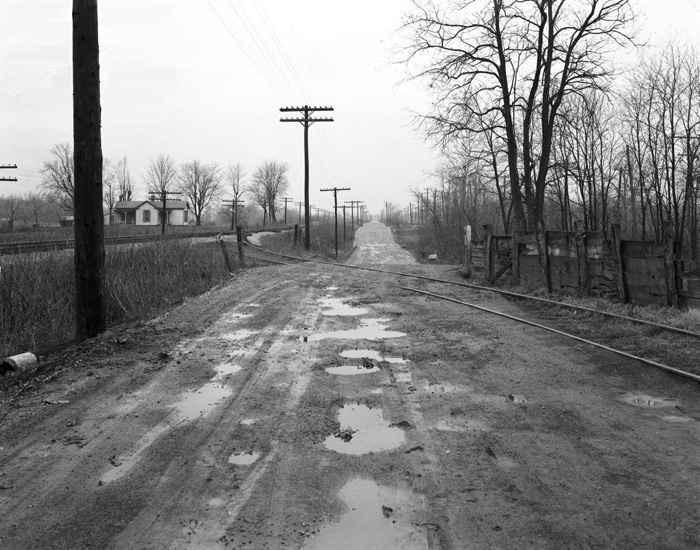A century ago, if you were travelling outside of the center city, you wanted to be on a train. Just take a look at Frankfort Avenue up above from 1910. The dirt turnpike is muddy and full of potholes and would likely have been an unpleasant ride in a wagon or early automobile. Luckily for Louisvillians past, a state of the art interurban train ran parallel to the road providing a quick, reliable, and smooth ride out into the far reaching hinterlands.

While interurbans once ran out of Louisville like spokes on a wheel, none exist today. The line on Frankfort began Downtown and traveled out to Anchorage, Pewee Valley, and eventually LaGrange. Back in the heyday of Louisville rail, you could have caught the Louisville & Eastern Railroad’s Yellow Flyer train every half hour between 6:00am and 10:00pm with the day’s last train running at midnight.
These commuter trains could speed you in and out of Louisville at 65 to 89 miles per hour, breezing past motorists stuck in the mud. Imagine the convenience today of traveling nearly 90 mph out to St. Matthews, Lyndon, or Anchorage from a dense and thriving core city.
These interurban rail lines helped to fuel growth of Louisville’s early suburbs which were clustered in centers around train stops. Early “streetcar suburbs” were more dense and walkable by nature than their modern counterparts since residents would take the train to their daily destinations outside of their suburban core. As roads improved and cars changed from “toys” of the wealthy to daily modes of transportation, rail declined and has now become obsolete. In 1911, the L & E was bought by the Louisville & Interurban Railroad and ran until August 1935.



I love these old photos. What part of Frankfort Ave. is shown above?
I'd say, from the tracks crossing over the roadway, that this is near the crossing at Clifton Avenue, looking East towards St. Matthews.
There was also the Louisville, Harrods Creek and Westport RR, a commuter that ended in Prospect near Rose Island Rd. Prospect was named after the optimistic belief in extending the line to Westport. There are still bits of the right away visible in certain places along the river. The pilings for the small rail bridge over Harrods Creek are there today.
obsolete? More like unsubsidized. Unlike the upgraded road. If you subsidize a train on a similar level as you do roads, you get those streetcar suburbs. Look at Arlington, Virginia on the Metro for modern-day examples.
This picture has me curious. I honestly don’t think that is Frankfort Avenue. Think about the alignment. Nowhere does a rail presently cross at that angle and continue straight on in both directions. In Clifton, the roadway makes an angle and the “straight” part of the railroad runs westward parallel with New Main Street. That maybe further out for a siding that no longer exists. At Frankfort/Lexington/Chenoweth Lane, the railroad bends northeastwardly and runs parallel with Westport Road.
I’ve looked at some older maps I have and I cannot find a configuration like that above. So to be argumentative, I’m going to offer that that picture is either Dixie Highway looking northward in southwestern Jefferson County, where there is (to this day) a spur which crosses over like that at Kosmosdale (and Dixie is elevated at the floodwall), or that is LaGrange Road eastward somewhere beyond Evergreen Road at Anchorage.
Having said all that, in this picture the road, the railroad, and the telephone/telegrpah lines seem to go on and forever in a straight line. The only road which offers such a panorama is, indeed, eastward looking Frankfort Avenue.
Any one else with the deviate thoughts?
I have to agree with Jeff. For 1910 that stretch of Frankfort Ave looks pretty vacant for Clifton.
The top picture is on Frankfort Avenue just past the Water Company. (There are numerous sidings in the area, most of them not used and some buried.) If you drive or ride that stretch you can still see how the road travels up and down like a wave in that section. David’s rail line was also called the “InterUrban”. It was used by those in the River Road area to commute into downtown. There have been many who would like to reuse the space for a multi-use path, but the ownership seems to be with the multiple owners along River Road.
Thanks for the update on the photo, John. It’s amazing how rural Louisville became so quickly compared to today. What’s even more amazing is that 100 years ago you could go almost 90mph through town. Unless your doing something illegal, that hasn’t been possible for many many decades. And you could get nearly anywhere in the county as David points out. It’s really a shame we let our rail systems fall apart.
Interesting point as well, Cavan. It would be nice to see rail placed on an even playing field with roads. I’m not positive, but does anyone know if Frankfort Turnpike was built by private interests and funded by tolls before it became an Avenue? I know that was the case for a while on Bardstown. The rail here was also built by private interests.
There is a toll house on Frankfort Ave. I think it is the site of the soon to be closing Ray Parrella’s.
Here’s a nice map on Wikipedia showing Civil War forts in Louisville. It gives a good look into city geography a mere 45 years before the photo was taken. I find it fascinating.
http://en.wikipedia.org/wiki/File:LouisvilleDefenses1865.jpg
I am the uploader of that map on Wikipedia. I was thrilled when my friend, historian Bryan Bush gave me a copy of it. I immediately realized that this public domain material needed to be scanned and put on the Internet quickly, as it contained data I thought the public would be very interested to discover.
I added it to two very fascinating articles (one them that I started based on Bush’s work) in the Wikipedia: Louisville in the American Civil War, and American Civil War fortifications in Louisville. I very much recommend them to every Louisville history buff.
http://en.wikipedia.org/wiki/Louisville_in_the_American_Civil_War
http://en.wikipedia.org/wiki/American_Civil_War_fortifications_in_Louisville
I’m not sure that is Frankfort Avenue at the Water Company. Per a 1913 map of Louisville (see the link below), the railroad spurs do not cross Frankfort Avenue in the same direction as is seen in the photo.
http://digital.library.louisville.edu/cdm4/document.php?CISOROOT=/maps&CISOPTR=206&CISOSHOW=111
The picture was part of the now long defunct Louisville Herald-Post collection and was obtained when that collection was public domain.
It was labeled with date and locale precisely as posted. It’s amazing how poor road conditions were in what was considered “in-town” areas. To wit, I have one photo of similar date with a Jeffersonville interurban car boarding at the station near Spring & Court. A dolled up lady passenger with ankle length skirt and boots is shown crossing the street which is dirt topped off with countless “horse-apples” the true residue of the more common transportation of the era. Remember most families did not own automobiles. It’s no small wonder that the electric trains with their heated roomy compartments, comfy seating, on-board restrooms and water coolers, sure beat looking at the rear end of a horse and swatting at horseflies for half a day or more while traveling to or from the ex-urbs. The overriding message in these two photos is roads were terrible. Even if you happened to own a car that meant very little in poor weather or fine. You still encountered seas of mud, potholes or clouds of dust when the sun was out.
I think it IS Frankfort Ave. at the Water Company, looking west to Clifton, and not east to St. Matthews. What I think happened is the picture was mistakenly printed in reverse. If you reverse it in Photoshop, and compare it with the map linked above it seems to fit. The map shows the railroad spur crossing Frankfort right at the intersection of Stiltz. There seems to be a road beyond the wooden fence that runs downhill at an angle, just like Stiltz, and that is where the spur crosses.
So, for those not familiar with the street names, the corner you are looking at, just beyond the wood fence, is where Mom’s Music Shop used to be.
-Eric
I am inclined to accept Eric’s theory. I flipped the picture as suggested. I want to believe that is what it is, as I said in my first answer, where I suggested this wasn’t Frankfort Avenue – still, no other series of road, rail, and telephone lines offer a similar panorama.
Very early Sunday morning I went out there with my picture and stood in the center of the road at the Hillcrest stoplight to try to compare the elevation of Frankfort Avenue headed into town. Frankfort does dip here and there lookig toward town. Driving in a car you don’t realize it, but if one were walking or biking, there are definite changes in elevation.
Unrelated, one notices that old wooden fence in the picture. Has anyone noticed the new wooden fence the Water Company has erected on the east end of their property along Frankfort Avenue? I’m not sure what they are hiding, but the fence looks horrible in my opinion.
My father and I were saying the same thing. The gates are always open, so it’s not like they’re protecting anything. In fact, it makes it much easier for someone to steal or vandalize the cars there because they’re now hidden. The fence is just plain ridiculous and ugly. They’ve messed up what used to be a very nice part of Frankfort Ave.
-Eric